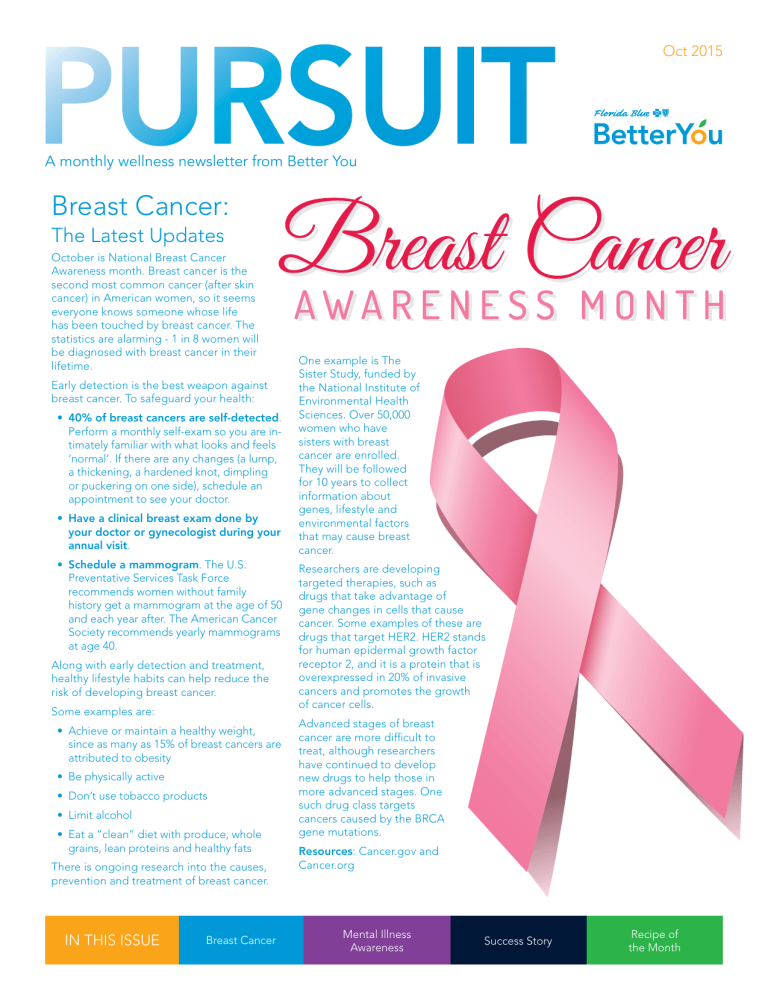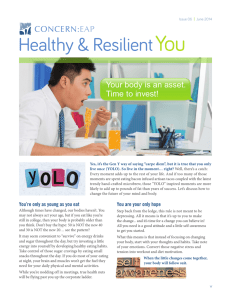PURSUIT Breast Cancer: The Latest Updates A monthly wellness newsletter from Better You

PURSUIT
A monthly wellness newsletter from Better You
Breast Cancer:
The Latest Updates
October is National Breast Cancer
Awareness month. Breast cancer is the second most common cancer (after skin cancer) in American women, so it seems everyone knows someone whose life has been touched by breast cancer. The statistics are alarming - 1 in 8 women will be diagnosed with breast cancer in their lifetime.
Early detection is the best weapon against breast cancer. To safeguard your health:
• 40% of breast cancers are self-detected .
Perform a monthly self-exam so you are intimately familiar with what looks and feels
‘normal’. If there are any changes (a lump, a thickening, a hardened knot, dimpling or puckering on one side), schedule an appointment to see your doctor.
• Have a clinical breast exam done by your doctor or gynecologist during your annual visit .
• Schedule a mammogram . The U.S.
Preventative Services Task Force recommends women without family history get a mammogram at the age of 50 and each year after. The American Cancer
Society recommends yearly mammograms at age 40.
Along with early detection and treatment, healthy lifestyle habits can help reduce the risk of developing breast cancer.
Some examples are:
• Achieve or maintain a healthy weight, since as many as 15% of breast cancers are attributed to obesity
• Be physically active
• Don’t use tobacco products
• Limit alcohol
• Eat a “clean” diet with produce, whole grains, lean proteins and healthy fats
There is ongoing research into the causes, prevention and treatment of breast cancer.
One example is The
Sister Study, funded by the National Institute of
Environmental Health
Sciences. Over 50,000 women who have sisters with breast cancer are enrolled.
They will be followed for 10 years to collect information about genes, lifestyle and environmental factors that may cause breast cancer.
Researchers are developing targeted therapies, such as drugs that take advantage of gene changes in cells that cause cancer. Some examples of these are drugs that target HER2. HER2 stands for human epidermal growth factor receptor 2, and it is a protein that is overexpressed in 20% of invasive cancers and promotes the growth of cancer cells.
Advanced stages of breast cancer are more difficult to treat, although researchers have continued to develop new drugs to help those in more advanced stages. One such drug class targets cancers caused by the BRCA gene mutations.
Resources : Cancer.gov and
Cancer.org
Mental Illness
Awareness
IN THIS ISSUE
Breast Cancer Success Story
Recipe of the Month
Oct 2015
Mental Illness Awareness:
Eating Disorders
We all have times when we have no appetite, or when we seem to want to eat everything in sight. Occasional periods like this are not of great concern. However, the practice of consistently eating too much or too little may be signs of an eating disorder. Eating disorders affect both men and women of all ages. According to WebMD, “eating disorders are a group of conditions marked by an unhealthy relationship with food.”
The three most common types are anorexia nervosa, bulimia nervosa, and binge eating disorder. These are defined as follows:
• Anorexia nervosa (also known as anorexia) is a potentially life-threatening eating disorder described by an abnormally low body weight, intense fear of gaining weight, and a distorted view of weight or shape
• Bulimia nervosa (also known as bulimia) is a potentially life-threatening eating disorder characterized by episodes of eating large amounts of food in a short time (bingeing) and then try to rid of the extra calories in unhealthy ways (purging)
• Binge-eating disorder is characterized by frequently eating too much food (binge) and then feeling a lack of control over eating; however, not followed by trying to rid of the extra calories
One of the challenges in medically diagnosing eating disorders is that people with these behaviors are likely to deny their condition, preventing treatment in the early stages. However, if friends and loved ones identify the signs and symptoms early, they may be able to assist before the matter worsens. Talking about it won’t be easy!
Someone struggling with an eating disorder may be depressed about something else that is leading to this behavior. If you or a loved one is suffering from any of these conditions seek medical attention; meanwhile there are ways to make the behavior less intense, which include but is not limited to the following:
• Yoga and meditation
• Reading self-help books
• Not stepping on a scale
• Finding support
• Starting a new hobby
Regardless of all the complexity there is a positive outcome once a call for assistance is obtained and support is provided to the individual. Ask your Human Resources department for more information about your
Employee Assistance Program.
Resource : WebMD.com
Success Story:
Karen’s total lifestyle change with help from the Better You
Nutrition Program.
“I’m Karen Byrne, and I’m a Technology
Project Manager at the Tampa Housing
Authority. Over the past few years, even though I eat a pretty healthy diet, I’ve gained a considerable amount of weight due to a lack of portion control, not exercising, and a slower metabolism (that comes with age). Having been an athlete most of my life (a competitive springboard diver), I was determined to lose the weight and get healthy and fit again. Using prayer coupled with commitment, I signed up for a “weight-loss challenge” offered through work, which started on May 4th, 2015. I was doing pretty well, but really started losing weight during the Better
You Nutrition class. I used the information in the class to totally change my eating habits and committed myself to exercising
EVERY DAY .
Instead of making small changes every week, I just went for it...and decided to revamp my entire diet...all at once! I eliminated all sugar, refined carbohydrates, and processed food from my diet and bought every vegetable the grocery store carried.
Then I went home, planned my meals and put the food in containers. It took a couple of weeks and bit of effort to overhaul my diet, but it’s amazing how fast your life will change. I have already lost 21 lbs. in 11 weeks by eating healthy, counting calories and exercising (swimming 1/4 mile every day) and I feel terrific. I have 20 lbs. to go to reach my ideal weight, but it will be a breeze now that I’m doing all the right stuff. More than anything, the class gave me a challenge as well as the accountability to succeed. Even better, my mom and my sister joined me and each lost over 15 lbs. as well, and now my Document Imaging Team at work has also joined in “to get fit” by doing circuit workouts and eating right every day, for the next 10 weeks. The Better You
Nutrition program proved to be a catalyst for a total lifestyle change. It only takes a spark to get a fire going!”
OCT 2015 2
MY HEALTHY
TURNAROUND!
My Healthy Turnaround is a CDC approved program administered through your local YMCA in South,
Northeast, Central and West Coast
Florida. The program focuses on losing 5% body weight and increasing physical activity by 150 minutes a week. The program includes weekly sessions with a lifestyle coach in a group setting to learn lifestyle changes that can positively affect the onset, or delay the effects of, diabetes, including:
• Weekly weigh-in, food log, and physical activity tracking;
• How to lose weight through healthy meal planning;
• Understanding food and nutrition labels;
• Diet, exercise and healthy lifestyle changes; and
• Group support and encouragement
To help you stay on track, following the program, there are maintenance sessions which will be held once a month.
Please note: individuals who have already been diagnosed with either Type 1 or Type 2 diabetes do not qualify for this program.
To host an on-site class at your work location, please contact
David.Carter@floridablue.com or your local YMCA. If you are interested in enrolling, please call
1-855-237-4106 9 a.m. - 9 p.m.,
ET to join a class.
Fresh and
Healthy
Recipe of the month
Kale, Carrot and
Apple Salad
Emerald-green lacinato kale is the star of this healthy kale salad, tossed with an easy maple, mustard and apple cider vinaigrette and studded with crisp apples. Toss or massage the kale with the dressing about 30 minutes before you’re
PHOTO COURTESY: EATINGWELL.COM
ready to serve. The sturdy kale leaves won’t wilt from the dressing and will taste even better after they’ve been marinated in it.
Ingredients
:
Cider Vinaigrette
• 1 small shallot, chopped
• 1/4 cup cider vinegar
• 3 tablespoons extra-virgin olive oil
• 2 tablespoons apple cider
• 1 1/2 tablespoons whole-grain mustard
• 2 teaspoons pure maple syrup
• 1/2 teaspoon salt
• Ground pepper to taste
Salad
• 10 cups coarsely chopped lacinato kale (1-2 large bunches)
• 2 sweet-tart apples, such as Golden Russet or Jonagold, cut into matchsticks
• 3 cups matchstick-cut carrots
• 1 cup matchstick-cut radishes
• 3/4 cup flat leaf parsley leaves, coarsely chopped
Preparation
:
1. To prepare vinaigrette: Puree shallot, vinegar, oil, cider, mustard, maple syrup, salt and pepper in a blender or mini food processor until smooth and creamy.
2. To prepare salad: Toss kale, apples, carrots, radishes and parsley in a large bowl.
Drizzle with the dressing; toss to coat.
Make Ahead Tip
: Cover and refrigerate the dressing (Step 1) for up to 2 days.
Bring to room temperature before tossing with the salad. Dress the salad (Step 2) up to
30 minutes ahead.
Nutrition
: Serving Size: 1 1/4 cup; 95 calories; 4 g fat (1 g sat, 3 g mono); 0 mg cholesterol; 13 g carbohydrates; 1 g added sugars; 5 g total sugars; 3 g protein; 3 g fiber; 175 mg sodium; 421 mg potassium.
Recipe courtesy of EatingWell.com
67271 0915
Florida Blue is a trade name of Blue Cross and Blue Shield of Florida, Inc., an Independent Licensee of the
Blue Cross and Blue Shield Association. All materials, content and forms contained in this newsletter are the intellectual property of Better You and may not be copied, reproduced, distributed or displayed in full or in part without expressed written permission by Better You.
OCT 2015 3






